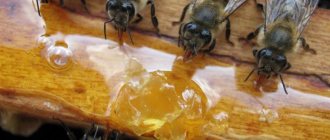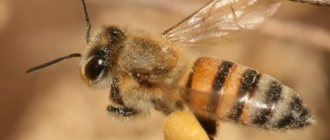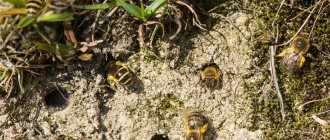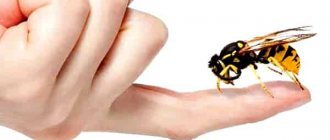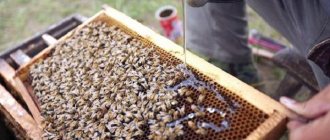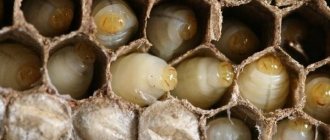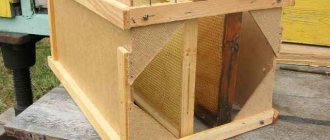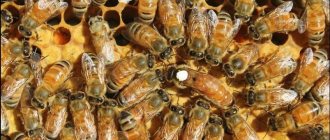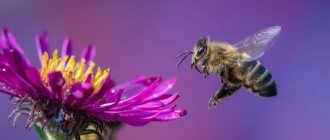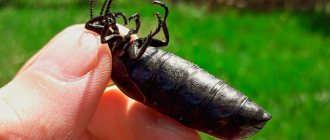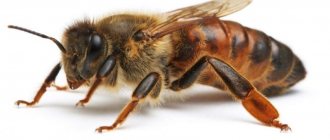The honey bee is one of the most important insects in Russia and the world. At the same time, this is one of those species whose population is too small in relation to the need. The main task of the honey bee is not the production of honey, as its name suggests. First of all, it is responsible for pollinating the flowers of plants that constitute food for people and animals. Without it, losses in the economy would be multi-billion dollar. Why is the honey bee so beneficial? How long does an insect live and where? We will answer these and many other questions in the further part of the article.
flower lover
- Transfer is necessary for seeds to form.
- pollen from one plant to another .
- This process is called pollination.
- When bees collect pollen, they typically visit many flowers of the same plant species in succession.
- At the same time, pollen sticks to the numerous hairs of their body, which they transfer from flower to flower.
Common mother
- The life of bees takes place in colonies, and each of these colonies (living in one hive) has one single mother - the queen bee.
- Throughout the summer, the queen bee lays up to 20 thousand eggs daily.
- She carefully places each egg in one of the wax cells specially prepared for this purpose.
- After 3 days, a small larva emerges from the egg. Whatever the bee later becomes - a worker, a queen or a drone, the life of a bee begins with a tiny egg.
Heir to the throne
- The queen lays some of her eggs in especially large cells, the so-called “queen cells”.
- Future queens are raised in them, the development of which lasts only 16 days.
- The larvae from which the queens emerge feed only on bee milk and become much larger than the workers.
- The young queen, the first to emerge from the pupa, immediately kills her potential rivals, since there can only be one queen. The former queen flies away from the hive.
Diligent people
- Bees work throughout the summer.
- The life of bees is that they must lay down huge reserves of honey and pollen in order to feed a large bee colony: from forty to eighty thousand bees live in one hive.
- Female workers are engaged in different types of activities: in accordance with their age. They build honeycombs, feed larvae, collect nectar and pollen, lay down honey and guard the entrance to the hive.
The life of bees or what happens in the hive during the year!
Birth of bees
All bees from conception to birth go through the same stages of development: egg, larva, pupa. Only the timing of the transition from one stage to another is different.
From the moment the egg is laid, embryonic development begins in it, i.e. cell division.
Fertilization of the egg occurs at the moment it leaves the uterine body. The egg looks like a tiny “piece of white thread.” The average length is about one and a half millimeters, the width is a third of a millimeter. The first day the egg stands upright. On the second day - at an inclination of 4-5 degrees. On the third day, the egg lies at the bottom of the cell.
Based on these characteristics, his age is determined. By this time, the larva emerges from the egg. Nurse bees begin feeding them with Royal Jelly, which is produced in their pharyngeal glands. Queen larvae are especially abundantly supplied with royal jelly.
During the first three days, all larvae develop in the same way. But then the “menu” of the larvae of worker bees and drones changes - they begin to be fed with a honey bee mixture. And the queen larvae continue to be abundantly supplied with Royal Jelly. Due to its high calorie content, the development of future queens is much faster than the development of future bees and drones.
It is estimated that nurse bees visit each larva about 1,300 times per day. And during the entire larval period - about ten thousand times.
The larval period for a worker bee lasts six days, for a drone - seven, and for a queen - five days. During this time, their weight increases compared to the weight of the egg by 1300 times. Four molts occur at this stage.
Then their feeding stops, and the cells are sealed with breathable wax caps. Within 3 days, the larva transforms into a pupa. The pupal stage of the drone lasts 14 days, the worker bee 12 days, and the queen bee only eight days.
In total, the entire development period of a bee is: for a worker bee - 21 days, for a queen - 16 days, for a drone - 24 days.
Bee development time may vary slightly depending on temperature. The optimal temperature near the brood is +34 degrees. When it decreases by at least one degree, the development of the brood is delayed. With significant temperature fluctuations, the brood dies.
Knowing the timing of development at all stages, the beekeeper can calculate the time when the “young animals” emerge. The age of open brood is determined more accurately. Sealed - approximately. Older pupae have lids of a darker tone.
In practice, it is especially important to know the age of the queen cell. If you make a mistake, you can lose both the swarm and the young queens.
Sometimes bees prevent young queens from emerging for some time. This occurs under unfavorable weather conditions when the swarm is unable to leave the hive.
Working in the hive
The life of a worker bee is divided into two periods.
At a young age, she is busy with housework - she is a hive bee. Newborns are weak, inactive, and cannot fly yet. It is not difficult to distinguish young bees from their older sisters - they are gray and fluffy, like hatched chickens.
Young bees gain strength for two or three days, warming the brood with their warmth. Having grown stronger, they join the working rhythm of the family. Prepare the cells for laying eggs: clean and polish them. The larvae are fed with a honey mixture. They take nectar, water and pollen from flying bees and distribute them among the cells. They rebuild the honeycombs, ventilate the hive, etc.
Bees never finish work they start. They do everything together, constantly switching from one type of activity to another.
Young bees have a well-developed ability to secrete wax plates, which deteriorates with age. Knowing this feature, you need to use the construction potential during the period of the most rapid growth of the family. During this period, the quality of new cells is better.
After a week and a half of hive work, the grown-up shift switches to flight field work. With a large loss of old bees, with an abundant harvest, this period decreases. And if necessary, the opposite happens - some of the flying bees begin hive work.
Bees master flight work in stages. At first they carry water, then they learn to collect pollen and only then begin to collect nectar. Some of the older, more experienced individuals look for new honey plants and become scout bees. They are also different in appearance - their backs seem to be worn out and bald. The optimal distance for honey collection is considered to be a radius of three kilometers. Bees fly for nectar and much further - up to five to seven kilometers. But this requires much more effort and more summer bees are lost.
Lifespan of bees
The lifespan of worker bees depends on the workload and external climatic factors. During the period of a small supporting bribe it is 35-40 days. With abundant honey collection - less. Bees going into winter have the longest life expectancy. They appear in early autumn, when the honey harvest is over. The uterus at this time reduces sowing.
The body of late bees is not worn out by work. In addition, they accumulate special protein substances, i.e. fat bodies. All this contributes to life expectancy until a new generation of young bees hatches.
By mid-May, in central Russia there are no old, overwintered bees left in the colonies.
Unwanted visit
- The life of bees is not only about nectar and ambrosia, but also about the struggle for survival.
- Sweet honey attracts many gourmets, and therefore predatory insects like ants and wasps often try to penetrate the hive. If the bees notice an invader, they will bite to death.
- Large enemy corpses that cannot be removed from the hive are embalmed by bees using propolis to avoid rotting.
Evolution of bees
First, a few words about evolution in general. You can often hear or read the following: “animals have adapted to the cold.” Or: “plants secrete nectar to attract insects.” It is clear that this is a figure of speech, or such a convenient image. But this image gets stuck in the head so much that students at school have to get used to it for a long time.
Animals have not adapted and do nothing for anything. They have simply survived to this day because they have these skills by nature. The rest of the colossal diversity of flora and fauna happily died out before us.
It is only worth adding that nature gradually isolated certain abilities from the living world. That is, evolution was underway.
The bee, as an individual insect, is perfectly equipped. She can fly and get food. Bees distinguish and remember the landscape of the area. Also, they perfectly distinguish colors, tastes, smells and remember them.
But bees cannot live alone. If an individual bee is isolated, it will become very agitated. As a result, in a very short period of time, she will waste all her vital resources. The bee will no longer be able to recover.
In nature, alone, a bee will freeze from the moderate night freshness. While the bee family calmly withstands forty-degree frost.
Important Steps
- The life of bees is short and it is divided into several stages
- Throughout the summer, the queen bee lays eggs.
- After three days, small larvae appear, which are fed by nurse bees.
- The larvae grow quickly and develop into pupae, from which they emerge as worker bees, queen bees, or drones.
- The workers first perform various duties inside the hive, and then fly outside it as nectar and pollen collectors.
What does a honey bee look like?
It belongs to the hymenoptera insects of the phylum arthropods. It has two pairs of wings with a membrane, thanks to which it stays in the air. On the third pair of legs, the honey bee has containers (baskets) designed to transport pollen. Bees have a defensive organ - a sting, which in a dangerous situation is stuck into the body of a potential aggressor, injecting poison. The sting is located at the end of the insect's abdomen. Drones, that is, male bees, do not have a stinger. Bee venom is not dangerous for a healthy person, provided there is no allergy. In other cases, a bee sting ends only with swelling.
Territorial distribution
When it comes to occurrence, the honey bee is popular under any latitude. If initially these insects were distributed throughout Europe, Western Asia and North Africa, today their various species are found on all continents.
The honey bee is one of the world's most important pollinating insects. Because of the transport of pollen, it is highly valued economically and naturally, providing great benefits to plants and most trees. It is believed that pollination of various plants by bees can double crop productivity. Every year, in Russia alone, such a bee, as a result of pollination, increases the harvest by several billion rubles.
Lifestyle of bees
- Honey bees lead a strictly organized lifestyle.
- The community consists of 40 to 80 thousand individuals.
- There is only one queen in each such colony.
- Bees fly out only in spring and summer to collect nectar and pollen.
- Few of them survive the winter by feeding on the honey reserves in the hive.
- Before the appearance of the young queen, the former queen leaves the hive, taking with her about half of its population, and they look for a new nest.
Evolution of the bee family
And so - bees live in families. The bee family is one whole, strictly organized community of insects. The family is characterized by collective work and, accordingly, a high standard of living.
The high organization of individuals into a large community is also a product of evolution. This is more difficult to comprehend than the occurrence of successful physiological mutations. Which, in the future, are fixed in the next generations through descendants.
Figuratively speaking, all members of the bee family constitute unique cells of a single flesh. An individual cell is not capable of living outside the whole organism. Such an organism is a bee family organized by wise nature. The bee family is even called a super-organism.
A family of bees is a system of relationships between individuals, which has the highest harmony, expediency and coherence in the actions of all its members . Bees in a family have interdependence and brotherhood with the highest level of information exchange.
Poorly organized families could not form a reserve of honey for themselves. Or they couldn’t organize themselves properly for the winter. As a result, they died. Thus, natural selection took away the right to life from non-viable bee families.
For millions of years, evolution has polished this organism of the bee family. Therefore, it is not for nothing that the life of bees is associated with legends. People attributed human qualities to bees. They were confident that bees had intelligence. Ancient people believed that bees had their own state with a king, government and “people”. The collective mechanism of the bee colony was set as an example for people.
